sensor Lancia Ypsilon 2011 Owner handbook (in English)
[x] Cancel search | Manufacturer: LANCIA, Model Year: 2011, Model line: Ypsilon, Model: Lancia Ypsilon 2011Pages: 299, PDF Size: 13.35 MB
Page 14 of 299
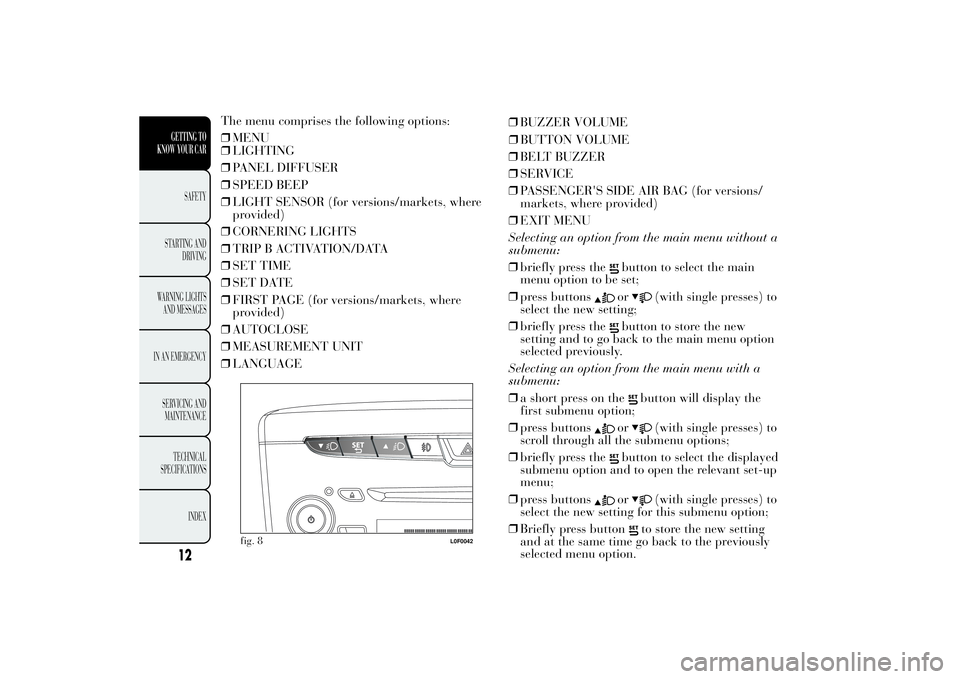
❒LIGHTING
❒PANEL DIFFUSER
❒SPEED BEEP
❒LIGHT SENSOR (for versions/markets, where
provided)
❒CORNERING LIGHTS
❒TRIP B ACTIVATION/DATA
❒SET TIME
❒SET DATE
❒FIRST PAGE (for versions/markets, where
provided)
❒AUTOCLOSE
❒MEASUREMENT UNIT
❒LANGUAGE❒BUZZER VOLUME
❒BUTTON VOLUME
❒BELT BUZZER
❒SERVICE
❒PASSENGER'S SIDE AIR BAG (for versions/
markets, where provided)
❒EXIT MENU
Selecting an option from the main menu without a
submenu:
❒briefly press the
button to select the main
menu option to be set;
❒press buttonsor
(with single presses) to
select the new setting;
❒briefly press the
button to store the new
setting and to go back to the main menu option
selected previously.
Selecting an option from the main menu with a
submenu:
❒a short press on the
button will display the
first submenu option;
❒press buttons
or
(with single presses) to
scroll through all the submenu options;
❒briefly press the
button to select the displayed
submenu option and to open the relevant set-up
menu;
❒press buttonsor
(with single presses) to
select the new setting for this submenu option;
❒Briefly press button
to store the new setting
and at the same time go back to the previously
selected menu option.
fig. 8
L0F0042
12GETTING TO
KNOW YOUR CAR
SAFETY
STARTING
AND
DRIVING
WARNING LIGHTS
AND MESSAGES
IN AN EMERGENCY
SERVICING AND
MAINTENANCE
TECHNICAL
SPECIFICATIONS
INDEX
The menu comprises the following options:
❒MENU
Page 16 of 299

Headlight sensor (automatic headlights/dusk
sensor sensitivity adjustment)(for versions/
markets, where provided)
This function is used to turn the headlights on or
off according to external light conditions.
The dusk sensor sensitivity can be adjusted
according to 3 levels (level 1 = minimum
sensitivity, level 2 = average sensitivity, level 3 =
maximum sensitivity); the greater the sensitivity
set, the less the external light variation needed
to turn on the lights (e.g. with a setting on level 3
at sunset the headlights switch on earlier in
relation to levels 1 and 2).
Proceed as follows to set:
❒press the
button briefly; the previously set
level will flash on the display;
❒press theor
button to make the
adjustment;
❒press the
button briefly to return to the menu
screen or give the button a long press to return
to the standard screen without storing.
Cornering lights (activation/deactivation of
cornering lights)(for versions/markets, where
provided)
This function activates/deactivates ("On"/"Off")
the cornering lights (see the description in the
“Exterior lights” paragraph).Proceed as follows to activate/deactivate the
lights:
❒press the
button briefly to make the display
flash On or Off according to the previous
setting;
❒pressor
to select;
❒press the
button briefly to return to the menu
screen or give the button a long press to return
to the standard screen without storing.
Activation/Trip B data (Activating Trip B)
With this function it is possible to activate ("On")
or deactivate ("Off") the Trip B display (trip
meter). For more information see the "Trip
computer" paragraph.
For activation/deactivation, proceed as follows:
❒press thebutton briefly to make the display
flash On or Off according to the previous
setting;
❒press theor
button to make the
adjustment;
❒press the
button briefly to return to the menu
screen or give the button a long press to return
to the standard screen without storing.
Time adjustment (Clock adjustment)
This function enables the clock to be set through
two submenus: “Time” and “Format”.
To carry out the adjustment, proceed as follows:
❒briefly press the button
: the display will show
the two submenus "Time" and "Format";
14GETTING TO
KNOW YOUR CAR
SAFETY
STARTING
AND
DRIVING
WARNING LIGHTS
AND MESSAGES
IN AN EMERGENCY
SERVICING AND
MAINTENANCE
TECHNICAL
SPECIFICATIONS
INDEX
Page 50 of 299

When the ignition key is turned to STOP or
removed and the ring nut is turned from O to
,
all the side lights and number plate lights switch
on. The
warning light will come on in the
instrument panel.
PARKING LIGHTS
These lights can only be turned on with ignition
key in STOP position or removed, by moving
the ring nut A first to positionOand then to
position.
The warning light
switches on on the
instrument panel. When the direction indicator
stalk is activated the side for the lights (left or
right) can be selected.
AUTOMATIC LIGHTING CONTROL
(AUTOLIGHT) (Dusk sensor)
(for versions/markets,
where provided)
This infrared LED sensor, combined with the rain
sensor and located on the windscreen, detects
the variations in outside brightness depending on
the light sensitivity set with the Setup Menu:
the greater the sensitivity, the less external light is
required to activate the exterior lights.
Activation
The dusk sensor activates when ring nut A fig. 34
is turned to
. In this way the side lights and
dipped headlights are activated automatically
according to the external light level.When the lights are turned on by the sensor, the
fog lights (for versions/markets, where provided)
and the rear fog lights may be turned on. When
the lights are automatically switched off, the front
and rear fog lights (if activated) are also switched
off. The next time the lights are switched on
automatically, the fog lights must be reactivated
manually (if required).
With the sensor active, it is possible to flash the
headlights but the main beam headlights cannot
be switched on. To activate these lights, turn
the ring nut A to
and activate the fixed dipped
beam headlights.
When the lights have been activated automatically
and are then switched off by the sensor, the
dipped beam headlights are switched off first,
followed by the side lights a few seconds later. If
the sensor is activated but is malfunctioning,
the side lights and dipped beam headlights are
switched on irrespective of the outside light level
and the sensor failure is indicated on the
instrument panel display. It is also possible to
deactivate the sensor and switch on the side lights
and dipped beam headlights.
IMPORTANT The sensor is unable to detect the
presence of fog. Under these circumstances, these
lights are therefore turned on manually.
48GETTING TO
KNOW YOUR CAR
SAFETY
STARTING
AND
DRIVING
WARNING LIGHTS
AND MESSAGES
IN AN EMERGENCY
SERVICING AND
MAINTENANCE
TECHNICAL
SPECIFICATIONS
INDEX
Page 53 of 299

Move the stalk upwards (unstable position) to
limit operation to the time for which the stalk is
held in this position. When released, the stalk will
return to its default position and the wiper will
be automatically stopped.
With the ring nut A fig. 35 in position
, the
windscreen wiper will automatically adapt
operating speed to the speed of the vehicle.
With the windscreen wipers operational, if reverse
gear is engaged, the rear window wiper is
automatically activated.
Never use the windscreen wipers to
remove layers of snow or ice from the
windscreen. In such conditions, the
windscreen wipers may be subjected to
excessive stress and the motor protection,
which prevents operation for a few seconds,
may intervene. If operation is not restored
(even after using the key to restart the engine),
contact a Lancia Dealership.Do not operate the windscreen wiper
with the blades lifted from the
windscreen."Smart washing" function
Pull the lever towards the steering wheel (unstable
position) to activate the windscreen washer.
Keeping the stalk pulled for more than half a
second, with just one movement it is possible to
operate the washer jet and the wiper at the same
time.
The wiper stops working three strokes after the
stalk is released.
A further stroke after approximately six seconds
completes the wiping cycle.
RAIN SENSOR
(for versions/markets, where provided)
The rain sensor is located behind the rear view
mirror in contact with the windscreen fig. 36 and
has the purpose of automatically adjusting the
frequency of the windscreen wiper strokes
depending on the intensity of the rain during
intermittent operation.
The sensor has an adjustment range that varies
progressively from wiper still (no stroke) when the
windscreen is dry, to wiper at first continuous
speed (slow continuous operation) with intense
rain.
51GETTING TO
KNOW YOUR CARSAFETY
STARTING
AND
DRIVING
WARNING LIGHTS
AND MESSAGES
IN AN EMERGENCY
SERVICING AND
MAINTENANCE
TECHNICAL
SPECIFICATIONS
INDEX
Page 54 of 299

Activation
Move the right lever down by one click. The
activation of the sensor is signalled by a "stroke"
to show that the command has been acquired.
IMPORTANT Keep the glass in the sensor area
clean.
By turning ring nut B fig. 35 is it possible to
increase the sensitivity of the rain sensor to obtain
a more rapid variation between wiper still (no
stroke) when the windscreen is dry, to wiper
at first continuous speed (slow continuous
operation).
The increasing of the rain sensor sensitivity is also
signalled by a stroke of the wipers.
If the windscreen washer is used with the rain
sensor activated, the normal washing cycle is
performed, after which the rain sensor resumes its
normal automatic operation.Deactivation
Turn the ignition key to STOP. The next time the
vehicle is started (key turned to MAR), the sensor
is not reactivated. To activate the sensor, move
the stalk upwards or downwards and then to
central position. Rain sensor activation will be
indicated by at least one wiper “stroke” even if the
windscreen is dry.
The rain sensor is able to recognise, and
automatically adjust itself in the presence of the
following conditions:
❒presence of dirt on the controlled surface (salt,
dirt, etc.);
❒presence of streaks of water caused by the worn
window wiper blades;
❒difference between day and night.
Do not activate the rain sensor when
washing the car in an automatic car
wash.Make sure the device is switched off if
there is ice on the windscreen.
WARNING
Make sure the device is switched off
whenever the windscreen
must be
cleaned.
fig. 36
L0F0188
52GETTING TO
KNOW YOUR CAR
SAFETY
STARTING
AND
DRIVING
WARNING LIGHTS
AND MESSAGES
IN AN EMERGENCY
SERVICING AND
MAINTENANCE
TECHNICAL
SPECIFICATIONS
INDEX
Page 88 of 299
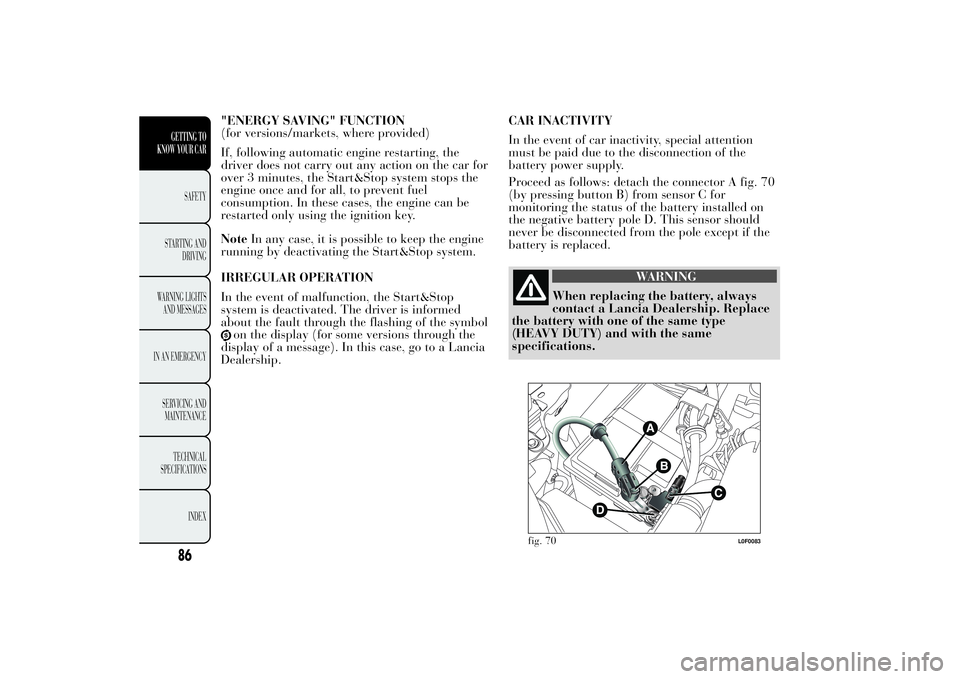
"ENERGY SAVING" FUNCTION
(for versions/markets, where provided)
If, following automatic engine restarting, the
driver does not carry out any action on the car for
over 3 minutes, the Start&Stop system stops the
engine once and for all, to prevent fuel
consumption. In these cases, the engine can be
restarted only using the ignition key.
NoteIn any case, it is possible to keep the engine
running by deactivating the Start&Stop system.
IRREGULAR OPERATION
In the event of malfunction, the Start&Stop
system is deactivated. The driver is informed
about the fault through the flashing of the symbol
on the display (for some versions through the
display of a message). In this case, go to a Lancia
Dealership.CAR INACTIVITY
In the event of car inactivity, special attention
must be paid due to the disconnection of the
battery power supply.
Proceed as follows: detach the connector A fig. 70
(by pressing button B) from sensor C for
monitoring the status of the battery installed on
the negative battery pole D. This sensor should
never be disconnected from the pole except if the
battery is replaced.
WARNING
When replacing the battery, always
contact a Lancia
Dealership. Replace
the battery with one of the same type
(HEAVY DUTY) and with the same
specifications.
fig. 70
L0F0083
86GETTING TO
KNOW YOUR CAR
SAFETY
STARTING
AND
DRIVING
WARNING LIGHTS
AND MESSAGES
IN AN EMERGENCY
SERVICING AND
MAINTENANCE
TECHNICAL
SPECIFICATIONS
INDEX
Page 94 of 299
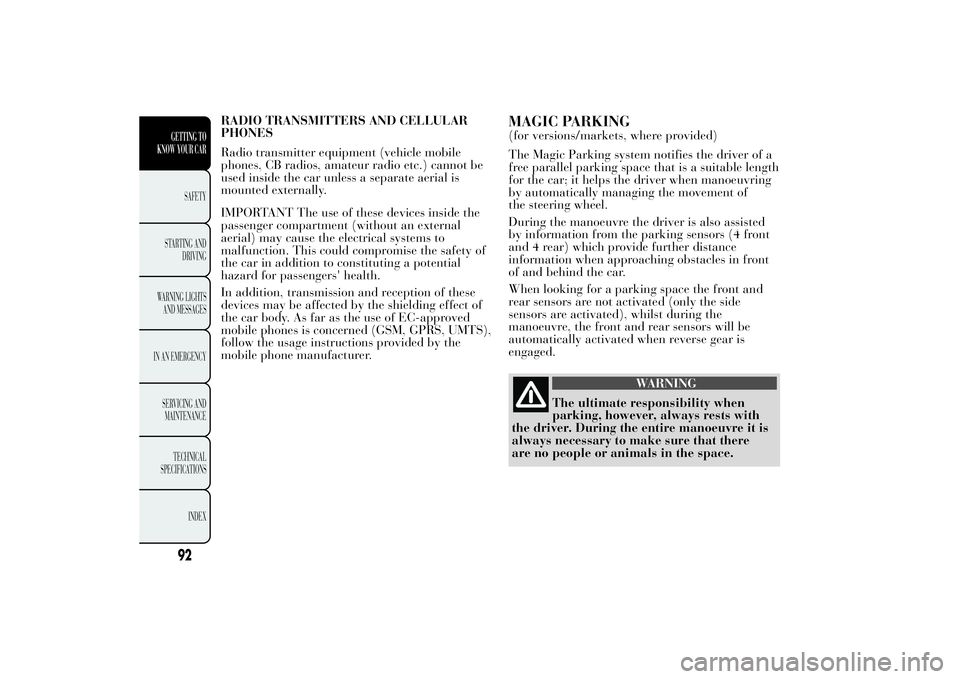
RADIO TRANSMITTERS AND CELLULAR
PHONES
Radio transmitter equipment (vehicle mobile
phones, CB radios, amateur radio etc.) cannot be
used inside the car unless a separate aerial is
mounted externally.
IMPORTANT The use of these devices inside the
passenger compartment (without an external
aerial) may cause the electrical systems to
malfunction. This could compromise the safety of
the car in addition to constituting a potential
hazard for passengers' health.
In addition, transmission and reception of these
devices may be affected by the shielding effect of
the car body. As far as the use of EC-approved
mobile phones is concerned (GSM, GPRS, UMTS),
follow the usage instructions provided by the
mobile phone manufacturer.
MAGIC PARKING(for versions/markets, where provided)
The Magic Parking system notifies the driver of a
free parallel parking space that is a suitable length
for the car; it helps the driver when manoeuvring
by automatically managing the movement of
the steering wheel.
During the manoeuvre the driver is also assisted
by information from the parking sensors (4 front
and 4 rear) which provide further distance
information when approaching obstacles in front
of and behind the car.
When looking for a parking space the front and
rear sensors are not activated (only the side
sensors are activated), whilst during the
manoeuvre, the front and rear sensors will be
automatically activated when reverse gear is
engaged.
WARNING
The ultimate responsibility when
parking, however,
always rests with
the driver. During the entire manoeuvre it is
always necessary to make sure that there
are no people or animals in the space.
92GETTING TO
KNOW YOUR CAR
SAFETY
STARTING
AND
DRIVING
WARNING LIGHTS
AND MESSAGES
IN AN EMERGENCY
SERVICING AND
MAINTENANCE
TECHNICAL
SPECIFICATIONS
INDEX
Page 95 of 299
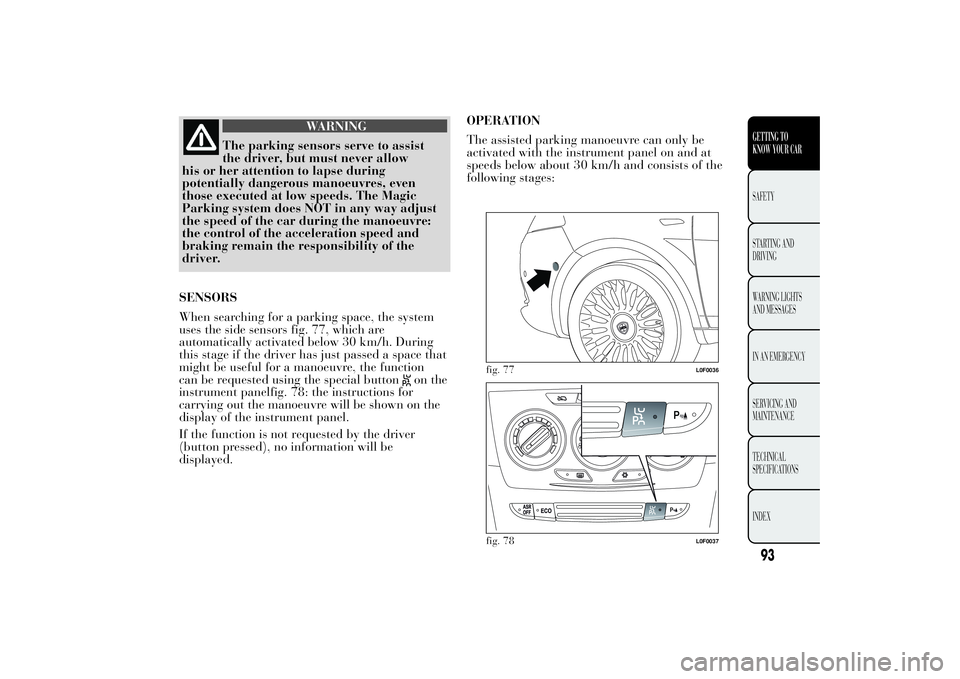
WARNING
The parking sensors serve to assist
the driver,
but must never allow
his or her attention to lapse during
potentially dangerous manoeuvres, even
those executed at low speeds. The Magic
Parking system does NOT in any way adjust
the speed of the car during the manoeuvre:
the control of the acceleration speed and
braking remain the responsibility of the
driver.
SENSORS
When searching for a parking space, the system
uses the side sensors fig. 77, which are
automatically activated below 30 km/h. During
this stage if the driver has just passed a space that
might be useful for a manoeuvre, the function
can be requested using the special button
on the
instrument panelfig. 78: the instructions for
carrying out the manoeuvre will be shown on the
display of the instrument panel.
If the function is not requested by the driver
(button pressed), no information will be
displayed.OPERATION
The assisted parking manoeuvre can only be
activated with the instrument panel on and at
speeds below about 30 km/h and consists of the
following stages:
fig. 77
L0F0036
fig. 78
L0F0037
93GETTING TO
KNOW YOUR CARSAFETY
STARTING
AND
DRIVING
WARNING LIGHTS
AND MESSAGES
IN AN EMERGENCY
SERVICING AND
MAINTENANCE
TECHNICAL
SPECIFICATIONS
INDEX
Page 96 of 299
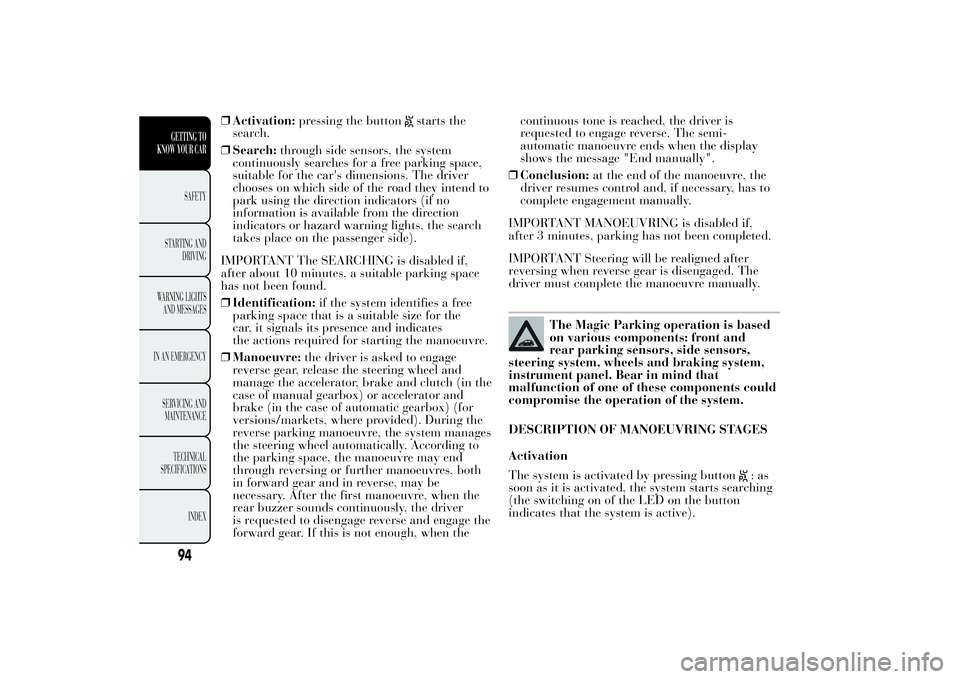
❒Activation:pressing the button
starts the
search.
❒Search:through side sensors, the system
continuously searches for a free parking space,
suitable for the car's dimensions. The driver
chooses on which side of the road they intend to
park using the direction indicators (if no
information is available from the direction
indicators or hazard warning lights, the search
takes place on the passenger side).
IMPORTANT The SEARCHING is disabled if,
after about 10 minutes, a suitable parking space
has not been found.
❒Identification:if the system identifies a free
parking space that is a suitable size for the
car, it signals its presence and indicates
the actions required for starting the manoeuvre.
❒Manoeuvre:the driver is asked to engage
reverse gear, release the steering wheel and
manage the accelerator, brake and clutch (in the
case of manual gearbox) or accelerator and
brake (in the case of automatic gearbox) (for
versions/markets, where provided). During the
reverse parking manoeuvre, the system manages
the steering wheel automatically. According to
the parking space, the manoeuvre may end
through reversing or further manoeuvres, both
in forward gear and in reverse, may be
necessary. After the first manoeuvre, when the
rear buzzer sounds continuously, the driver
is requested to disengage reverse and engage the
forward gear. If this is not enough, when thecontinuous tone is reached, the driver is
requested to engage reverse. The semi-
automatic manoeuvre ends when the display
shows the message "End manually".
❒Conclusion:at the end of the manoeuvre, the
driver resumes control and, if necessary, has to
complete engagement manually.
IMPORTANT MANOEUVRING is disabled if,
after 3 minutes, parking has not been completed.
IMPORTANT Steering will be realigned after
reversing when reverse gear is disengaged. The
driver must complete the manoeuvre manually.
The Magic Parking operation is based
on various components: front and
rear parking sensors, side sensors,
steering system, wheels and braking system,
instrument panel. Bear in mind that
malfunction of one of these components could
compromise the operation of the system.
DESCRIPTION OF MANOEUVRING STAGES
Activation
The system is activated by pressing button
:as
soon as it is activated, the system starts searching
(the switching on of the LED on the button
indicates that the system is active).
94GETTING TO
KNOW YOUR CAR
SAFETY
STARTING
AND
DRIVING
WARNING LIGHTS
AND MESSAGES
IN AN EMERGENCY
SERVICING AND
MAINTENANCE
TECHNICAL
SPECIFICATIONS
INDEX
Page 98 of 299
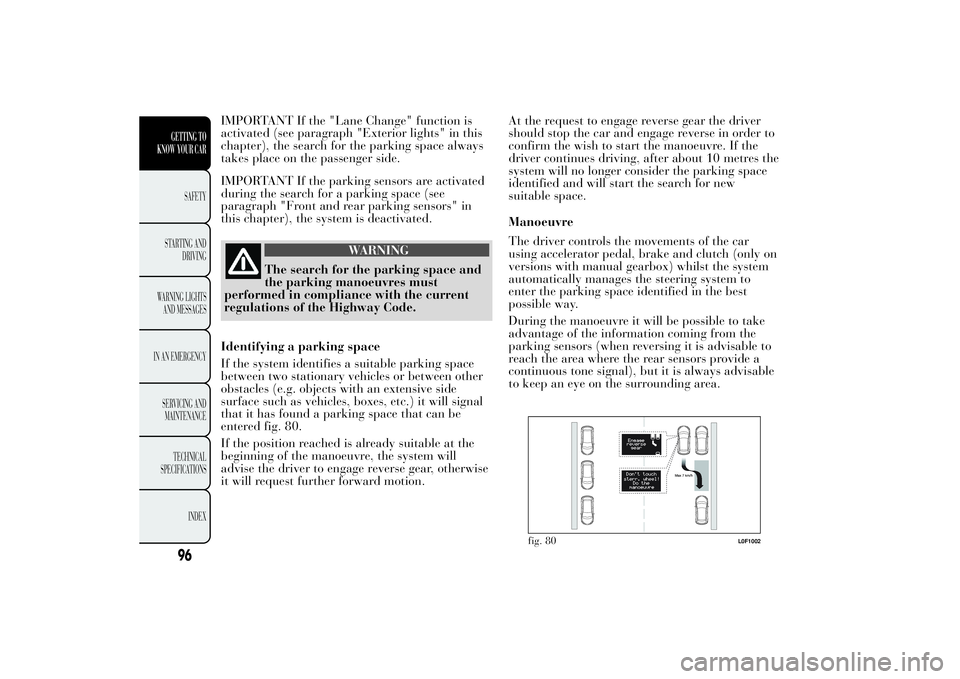
IMPORTANT If the "Lane Change" function is
activated (see paragraph "Exterior lights" in this
chapter), the search for the parking space always
takes place on the passenger side.
IMPORTANT If the parking sensors are activated
during the search for a parking space (see
paragraph "Front and rear parking sensors" in
this chapter), the system is deactivated.
WARNING
The search for the parking space and
the parking manoeuvres
must
performed in compliance with the current
regulations of the Highway Code.
Identifying a parking space
If the system identifies a suitable parking space
between two stationary vehicles or between other
obstacles (e.g. objects with an extensive side
surface such as vehicles, boxes, etc.) it will signal
that it has found a parking space that can be
entered fig. 80.
If the position reached is already suitable at the
beginning of the manoeuvre, the system will
advise the driver to engage reverse gear, otherwise
it will request further forward motion.At the request to engage reverse gear the driver
should stop the car and engage reverse in order to
confirm the wish to start the manoeuvre. If the
driver continues driving, after about 10 metres the
system will no longer consider the parking space
identified and will start the search for new
suitable space.
Manoeuvre
The driver controls the movements of the car
using accelerator pedal, brake and clutch (only on
versions with manual gearbox) whilst the system
automatically manages the steering system to
enter the parking space identified in the best
possible way.
During the manoeuvre it will be possible to take
advantage of the information coming from the
parking sensors (when reversing it is advisable to
reach the area where the rear sensors provide a
continuous tone signal), but it is always advisable
to keep an eye on the surrounding area.
fig. 80
L0F1002
96GETTING TO
KNOW YOUR CAR
SAFETY
STARTING
AND
DRIVING
WARNING LIGHTS
AND MESSAGES
IN AN EMERGENCY
SERVICING AND
MAINTENANCE
TECHNICAL
SPECIFICATIONS
INDEX